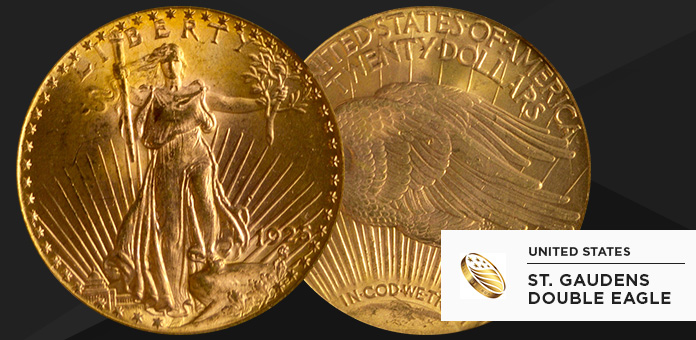
The early 20th century yielded some of the most brilliant coinage in the country’s history, with Augustus Saint-Gaudens’ Double Eagle serving as the paragon.
Augustus Saint-Gaudens’ Double Eagle: An Artistic and Political Feat
The high relief coinage of ancient Greece was the inspiration for Saint-Gaudens’ Double Eagle, and, indeed, it took a herculean effort on the part of President Theodore Roosevelt to press the U.S. Mint to produce them. In fact, in a letter to the president, Saint-Gaudens compared his compelling the contentious Chief Engraver Charles E. Barber to strike the coins to “putting through the Panama Canal.” Barber was apparently displeased that an individual not employed by the U.S. Mint designed the coin, despite the fact that this “outsider” was a famous and revered American sculptor. Barber also opposed the high relief artwork, citing the impracticality of striking and staking such coins. It took direct orders from Roosevelt to force him to start production in November 1907; by that time, Saint-Gaudens had died.
Augustus Saint-Gaudens’ Double Eagle Embodies American Values
Liberty, democracy, strength, and longevity—Saint-Gaudens’ Double Eagle beautifully expresses these founding American principles in precious metal for generation upon generation to behold. Liberty takes the shape of a robed women striding forth out of the rising sun holding the torch of enlightenment in front of her and the olive branch of peace out to the world. The bastion of democracy, the United States Capitol Dome, and the year rest at her feet with an inscription of “Liberty” above her head. Forty-six stars representing the states in the Union encircle this awe-inspiring image. Coins minted after 1911 bear forty-eight stars.
The obverse features perhaps one of the most dynamic depictions of our national emblem to ever grace American coinage: a bald eagle in profile soaring above the sun, rays of light seemingly propelling its wings up. Inscriptions of “United States of America” and “Twenty Dollars” border the top of the coin and “E Pluribus Unum” the edge. Versions of the coin struck after 1908 also feature an engraving of “In God We Trust.” Considering church a better place for God’s name than the bordellos, casinos, and saloons where coins were standard currency, Roosevelt at first tried to omit the motto, but Congress swiftly stepped in to mandate its inclusion.

Specs for the Saint-Gaudens Double Eagle Gold Proof:
| Gold | 90 percent |
| Copper | 10 percent |
| Face value | $20 USD |
| Thickness | 2.41 mm |
| Diameter | 34.1 mm |
Interesting Facts about Saint-Gaudens’ Double Eagle Proof Coin
- Requiring nine presses from the dies at a pressure of 172 tons, the first Double Eagles struck in 1907 are by far the most breathtaking presentations of Saint-Gauden’s vision. Coins produced for circulation after that received five presses and those for proof six or seven. After producing 11,250, Barber prevailed and changed the dies to create lower relief designs.
- Influenced by classical coins, Saint-Gaudens instructed for the year to be inscribed in Roman numerals, but when Barber changed the dies he also switched the inscriptions to Arabic numbers.
- Only 687 proof coins were made available for purchase between 1908 and 1915. With the exception of 1909 and 1910, which have a satin veneer, the proof coins were made with a matte finish.
Saint-Gaudens’ Double Eagles: Cherished Pinnacles of American Coin Design
Whether for their storied history, their distinct design, or their immense numismatic value, Saint-Gaudens’ Double Eagle proof coins are highly sought-after by collectors and investors. Rare specimens have sold for millions of dollars. For these reasons, the quest for these coins can be as fascinating as it is challenging.
If you’d like to learn more about rare coin investing, Scottsdale Bullion and Coin offers free resources and answers. Contact SBC today.

